Have you ever wondered, “Can you look at a solar eclipse without sunglasses? If so, you’re in luck. Welcome to this comprehensive exploration of solar eclipse safety!
This captivating solar event has intrigued humans for millennia, often surrounded by sky-high tales and myths. Let’s explore the science behind it, dispel the hype, and focus on safely engaging in eclipse viewing.
It’s commonly believed that you can watch solar eclipses with the naked eye. However, I’ll explore the risks and precautions needed to prevent damage to your eyes, such as solar retinopathy.
My goal is to ensure you’re well informed about the marvels and dangers an eclipse brings and that you walk away with a deep-rooted respect for nature’s power, with safety as the top priority.
In this article, you get to
Understand Solar Eclipse Types: Learn about the different types of solar eclipses, including total, partial, and annular, and what makes each unique.
Define Solar Eclipse Occurrence: Discover when and how solar eclipses occur, including the rarity of total solar and upcoming eclipse dates.
Differentiate Eclipse Types: Differentiate between a total eclipse, a partial eclipse, and annular solar eclipses, understanding their visibility, frequency, and duration.
Learn the Risks: Gain insights into the risks of looking at a solar eclipse without proper eye protection, including the potential for solar retinopathy.
Explore Eye Effects: Understand how seeing the sun during an eclipse can affect your eyes, leading to symptoms like blurred vision and blind spots.
Recognize Long-term Consequences: Realize the long-term consequences of unprotected eclipse viewing, such as difficulties in daily tasks and increased risk of eye diseases.
Evaluate Sunglasses: Discover why regular sunglasses are insufficient for solar eclipse viewing due to their inability to block harmful UV radiation.
Compare Sunglasses and Eclipse Glasses: Learn the differences between regular and approved solar eclipse glasses, including their safety standards and effectiveness.
Secure Your Eyes: Understand the importance of proper eye protection during a solar eclipse and how to use eclipse glasses, handheld solar viewers, pinhole projectors, and solar filters to ensure optimal eye health.
Safety During Totality: Explore safety measures during the totality phase of a solar eclipse, including when it is safe to view the sun without eye protection and how to identify signs of totality.
By the end of this article, you’ll be well-equipped with the knowledge and guidelines necessary to safely enjoy and appreciate the awe-inspiring phenomenon of a solar eclipse while protecting your eyes and debunking common myths.
Let’s dive right in.
Recommended For You
Understanding Solar Eclipse
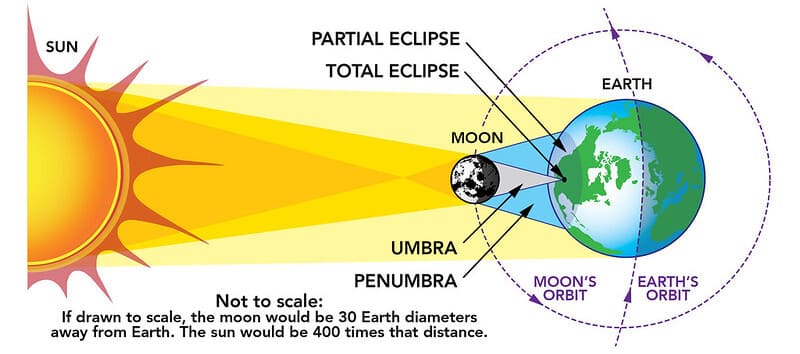
A solar eclipse happens when the moon’s orbit aligns with the sun and the Earth, casting a shadow on our planet.
Depending on the relative positions of these three celestial bodies, there are different solar eclipses:
- Total
- Partial
- Annular
Read my article on Hybrid Solar Eclipses.
Definition and Occurrence of Solar Eclipse

Experience the Marvel of a Total Solar Eclipse
Imagine this: the moon completely covers the sun’s disk, casting a fleeting shadow that envelops the world in darkness.
This captivating phenomenon is known as a total solar eclipse; you can witness it for yourself.
During this extraordinary event, the sun’s outer atmosphere, the corona, graces the sky as a delicate ring of light encircling the moon.
But here’s the catch—it’s not something you can see anywhere. A total solar eclipse is a rare spectacle, exclusive to a narrow path on Earth’s surface called the “path of totality.”
The duration of totality varies, lasting from mere seconds to a few precious minutes, contingent upon the location and the moon’s shadow speed.
Please mark your calendar as the next total solar eclipse will grace our skies on April 8, 2024, visible from select regions in Mexico, the United States, and Canada.
Read this article to learn how frequent solar eclipses are in the USA
A Glimpse of the Partial Solar Eclipse

Let’s focus on another celestial wonder—a partial solar eclipse.
During this cosmic dance, the moon covers only a portion of the sun’s radiant disk, casting a mesmerizing crescent-shaped sun. Unlike its total counterpart, a partial solar eclipse is visible over a broader geographical area. However, it doesn’t deliver the awe-inspiring totality experience.
Remember that a partial solar eclipse can occur independently or precede or follow a total eclipse. The most recent partial solar eclipse graced the skies on June 10, 2021, captivating viewers across North America, Europe, and Asia.
Witness the “Ring of Fire” – Annular Solar Eclipse

Picture this: a sun, encircled by a radiant ring of sunlight, as the moon positions itself just right. This phenomenon is known as an annular solar eclipse, often dubbed the “ring of fire” eclipse.
While it lacks the totality effect, an annular eclipse paints the sky with its unique charm. To witness this celestial marvel, you’ll need to be in the path of annularity, where the moon’s antumbra, the outer part of its shadow, takes its stage.
Annular eclipses are more frequent than total, yet they are no less extraordinary.
The last annular solar eclipse captivated our skies in October 2023. It was visible from various regions across North America, Central America, South America, and Africa.
Can you look at a solar eclipse without sunglasses? The Risk of Looking at Solar Eclipse without Protection
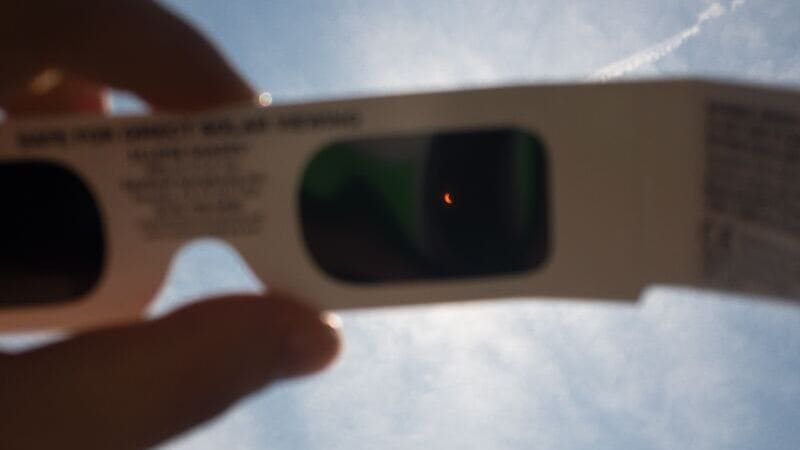
Looking at a solar eclipse without proper eye protection can harm your eyes.
The sun emits intense ultraviolet (UV) radiation that can damage the retina (the light-sensitive layer at the back of your eye) and cause solar retinopathy.
This can result in blurred vision, blind spots, or permanent eclipse blindness.
Effects on Eyes
Have you ever wondered why your pupils, those tiny black holes in your eyes, seem to have a mind of their own? Well, they play a crucial role in safeguarding your vision.
When confronted with a glaring light source, be it the sun’s brilliance or the beam of a flashlight, your pupils contract—like a built-in camera lens—limiting the amount of light that can enter your eyes. This nifty mechanism is your eyes’ way of ensuring your delicate retina isn’t overwhelmed by excessive brightness.
However, enter the extraordinary solar eclipse event, and things take an unexpected turn. The sun’s radiance dims during this cosmic spectacle, and your pupils might not contract as much as they should. This seemingly innocuous detail can lead to a potentially serious problem: an increased influx of harmful ultraviolet (UV) radiation into your eyes, putting your retina at risk of damage.
Here’s the twist—this damage isn’t always immediate or apparent.
Gazing at the sun during an eclipse may not trigger immediate discomfort or pain. It’s almost deceptive in its subtlety. Instead, hours or even days later, you might begin to notice unsettling symptoms.
Your vision might blur, colors distort, and you may find it more challenging to discern contrasts. Worst of all, you might detect blind spots in the center of your vision.
These symptoms could either gradually improve or, depending on the extent of the damage, become a permanent part of your visual landscape.
Remember, your eyes are precious, and their well-being is paramount.
So, when you embark on the journey to witness a solar eclipse, ensure you equip yourself with proper eye protection to savor the celestial show without jeopardizing your vision.
Long-term Consequences of Unprotected Viewing
Solar retinopathy is not to be taken lightly; it can cast a long shadow on your vision and overall quality of life. The extent of the damage can significantly affect your ability to carry out everyday tasks that hinge on clear vision, like reading, driving, or recognizing faces. Furthermore, as you journey through life, there’s an increased risk of developing other eye conditions, including macular degeneration and cataracts.
Unfortunately, when it comes to solar retinopathy, there’s no silver lining in the form of an effective treatment or a magical cure. The most reliable course of action is prevention.
To safeguard your precious eyes from harm, it’s imperative to steer clear of direct or even indirect sun gazing during a solar eclipse unless you’re equipped with the proper eye protection. Your vision’s well-being is in your hands.
Why Regular Sunglasses Are Not Enough
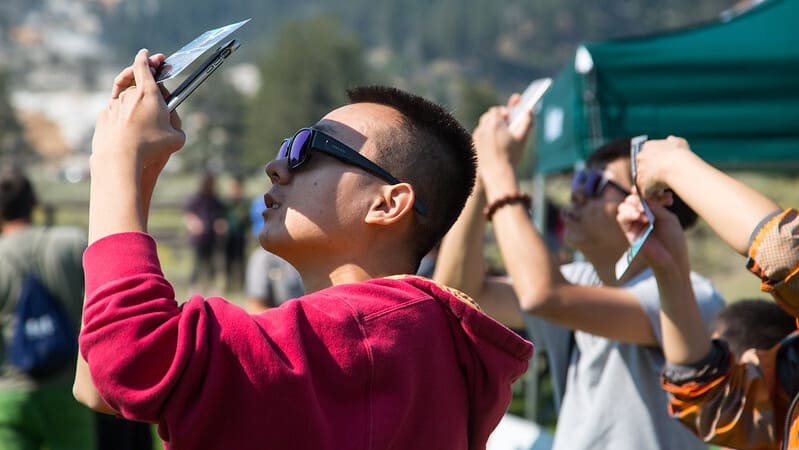
You may think wearing regular sunglasses can protect your eyes from the sun during a solar eclipse. However, this is not true.
Regular sunglasses are not designed to block the intense UV radiation from the sun.
They may reduce the glare and make the sun appear darker, but they do not filter out enough UV light to prevent eye damage.
Quality of sunglass lenses
The quality of sunglass lenses can vary widely depending on the brand, model, and price. Some sunglasses may have labels that claim to offer UV protection, but they may not meet international standards for safety and effectiveness. Some sunglasses may also have defects or scratches that can reduce their UV filtering ability.
Even if you have high-quality sunglasses offering 100% UV protection, they are still insufficient to protect your eyes from the sun during a solar eclipse. This is because sunglasses are designed to block only a fraction of the sun’s light, not the entire sun’s disk.
The sun is so bright that even a tiny amount of its light can damage your retina if you look at it directly or indirectly.
Differences between sunglasses and Eclipse Glasses
Solar Eclipse Glasses are no ordinary eyewear—they’re your trusted guardians against the sun’s intense light and harmful UV radiation. Tailored specifically for the celestial event, they’re a staggering thousand times darker than your run-of-the-mill sunglasses.
These stellar shades adhere to the rigorous ISO 12312-2 international standard for eye safety during solar observations, ensuring you can gaze at the sun’s radiant disk without concern for your precious peepers.
So, what makes these solar glasses so unique? Eclipse glasses sport frames made of either cardboard or plastic, while their lenses consist of ultra-thin sheets crafted from black polymer or aluminized Mylar. Affordable and readily available, you can easily snag a pair online or at your local store before a solar eclipse.
But here’s the thing—your safety hinges on a thorough inspection. Before you don your eclipse glasses, give them a once-over. If you spot any tears, scratches, or other damage, it’s best to bid them farewell and find a replacement. Safety always comes first.
Remember to supervise children using eclipse glasses if you’re sharing this celestial spectacle with the younger crowd. Ensure they’re wearing them correctly and securely for solar viewing. Every eye deserves protection.
A critical point: Eclipse glasses are separate from your everyday sunglasses or any other eyewear in your collection. Never layer eclipse glasses over regular or contact lenses; doing so compromises their effectiveness and raises the risk of eye damage.
And here’s a vital caution—never, under any circumstances, should you attempt to gaze at the sun through the lens of a camera, telescope, binoculars, or any other optical device while wearing eclipse glasses or using a handheld solar viewer. This ill-advised move can result in severe eye injury.
Read my article Can I take a photo of a solar eclipse?
Play it safe, use the right gear, and cherish the cosmic spectacle without risking your vision.
Securing Your Eyes During a Solar Eclipse

The only safe way to look at a solar eclipse is to use proper eye protection, such as eclipse glasses or a handheld solar viewer. These devices block almost all the sun’s light and UV radiation, allowing you to safely observe the sun’s disk and its changing phases during a solar eclipse.
Proper Eye Gear: Eclipse Glasses
To use eclipse glasses safely, follow these steps:
- Inspect your eclipse glasses before use and make sure they are not damaged, dirty, or expired.
- Put on your eclipse glasses before looking at the sun and adjust them to fit securely on your face.
- Look at the sun through your eclipse glasses and enjoy the view of the solar eclipse.
- Look away from the sun before removing your eclipse glasses.
- Refrain from using your eclipse glasses if they are damaged or over three years old.
Alternative Safe Methods: Pinhole Projector and Solar Filters

If you do not have eclipse glasses or a handheld solar viewer, you can use an indirect viewing method: a pinhole projector.
You can make your pinhole projector using a cardboard box, a sheet of paper, tape, scissors, and aluminum foil.
Follow these steps to make a pinhole projector:
- Cut a small hole in one end of the box and cover it with aluminum foil.
- Poke a small hole in the foil with a pin or a needle.
- Cut another hole in the opposite end of the box and tape the white paper inside the box behind it.
- Point the foil-covered hole toward the sun and adjust the box until you see a small image of the sun projected on the paper.
- Watch the image of the solar eclipse change as the moon moves across the sun.
Another way is to use a solar filter, a thin sheet of specially coated material that blocks most of the sun’s light and UV radiation.
You can attach a solar filter to a camera lens, telescope, binoculars, or any other optical device and safely view the sun through it.
However, you should never look at the sun through an optical device without a solar filter, as this can magnify the sun’s light and cause severe eye injury.
You can buy a solar filter online or in stores before a solar eclipse or make your own using a piece of #14 welder’s glass, aluminized Mylar, or a special purpose solar filter.
Follow these steps:
- Cut a piece of cardboard or paper slightly larger than the front of your optical device.
- Cut a hole in the center of the cardboard or paper and insert the solar filter material into it.
- Tape or glue the solar filter material securely to the cardboard or paper.
- Attach the cardboard or paper with the solar filter material to the front of your optical device.
- Point your optical device toward the sun and look through it with your eyes.
- Adjust your optical device until you see a clear image of the sun’s disk and its changing phases during a solar eclipse.
Safe Observation of Partial and Annular Solar Eclipses
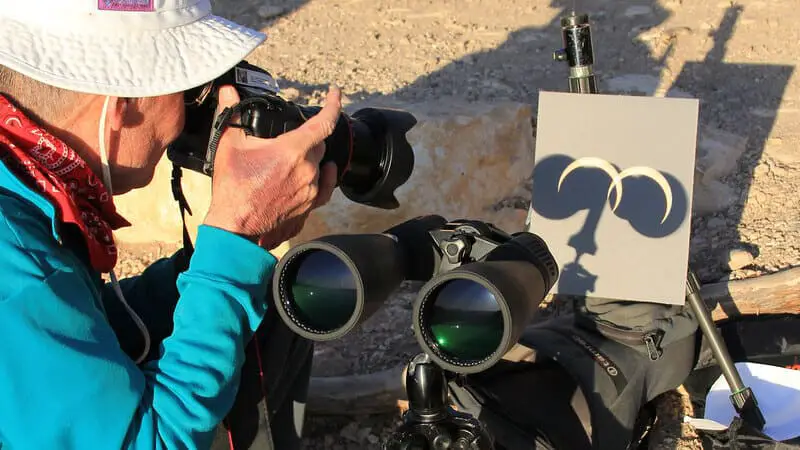
When you find yourself in an area where only a partial or annular solar eclipse is on the cosmic menu, it’s essential to prioritize eye protection.
Enter the day’s heroes: eclipse glasses or a trusty handheld solar viewer.
These safeguards are your key to safely witnessing the celestial dance above, as there’s no phase of totality during these eclipses. The sun’s disk remains partially visible throughout the event, meaning any unprotected glimpse can harm your eyes.
Now, here’s an essential rule of thumb: Steer clear of looking at the sun through any unfiltered optical device, whether it’s a camera lens, telescope, binoculars, or even a magnifying glass—yes, even if you’re wearing eclipse glasses or using a handheld solar viewer. These optical marvels have the knack of concentrating the sun’s intense light and heat, posing risks to your eyes and equipment.
So, what’s the safe route to follow?
If you intend to use an optical device to observe a partial or annular solar eclipse, ensure it’s equipped with a snug-fitting solar filter that securely covers the device’s front.
Safety is paramount, so remember to inspect your solar filter before every use. Ensure it’s pristine—no damage, dirt, or expiration. These precautions allow you to savor the celestial spectacle without compromising your safety or equipment.
Safety Guidelines During the Totality Phase of a Solar Eclipse
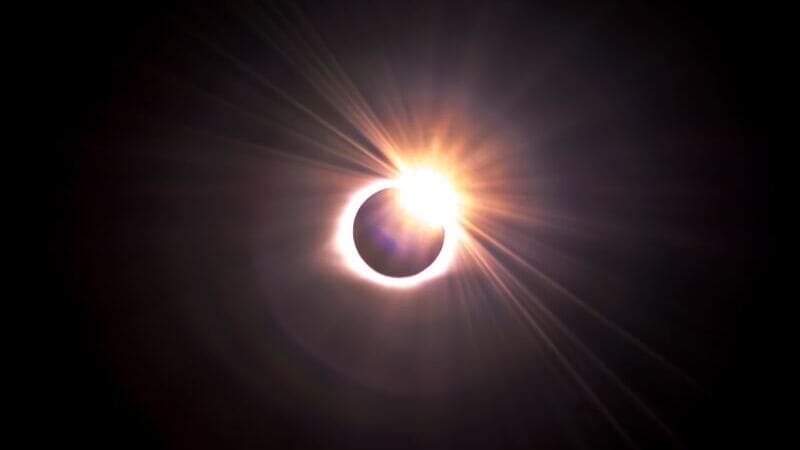
If you are in an area where you can see a total solar eclipse, you will experience a brief period of darkness called totality. During this time, the moon completely covers the sun’s disk and blocks all its light. The only visible thing is the sun’s corona, a faint ring of light around the moon. This is the most spectacular and awe-inspiring part of a solar eclipse.
During totality, looking at the sun without any eye protection is safe, as there is no risk of eye damage from UV radiation.
You can also use an unfiltered optical device to view the sun’s corona in more detail. However, you should be very careful and follow these safety guidelines:
Signs of Totality Phase

You should know when totality begins and ends in your location. You can use online tools, such as eclipse maps or eclipse timers, to find this information.
You should also pay attention to these signs that indicate totality is about to start or end:
- The sky becomes darker and cooler as the moon covers more and more of the sun’s disk.
- The sunlight fades and changes color, creating a twilight-like effect.
- The shadows become sharper and distorted as the sun becomes a thin crescent.
- You may see bright spots called Baily’s beads along the moon’s edge, caused by sunlight shining through valleys on the moon’s surface.
- You may see a bright flash called the diamond ring effect, which occurs when a single spot of sunlight remains visible on one side of the moon.
- You may hear animals making noises or behaving strangely, confused by the sudden darkness.
- You may feel a rush of excitement or emotion as you witness a rare and beautiful natural phenomenon.
Safety Measures
You should follow these safety measures to protect your eyes and enjoy totality safely:
- Wear your eclipse glasses or use your handheld solar viewer until the moment of totality, when the moon completely covers the sun’s disk.
- Remove your eclipse glasses or handheld solar viewer and look at the sun’s corona with your naked eyes or through an unfiltered optical device.
- Do not look away from the sun during totality, as you may miss the best part of the eclipse.
- Watch for the signs of totality ending, such as the diamond ring effect or Baily’s beads reappearing.
- Put on your eclipse glasses or handheld solar viewer as soon as totality ends and the sun’s disk becomes visible again.
- Do not look at the sun without protection until it sets or until the eclipse is over.
Myths and Misconceptions about Viewing Solar Eclipse
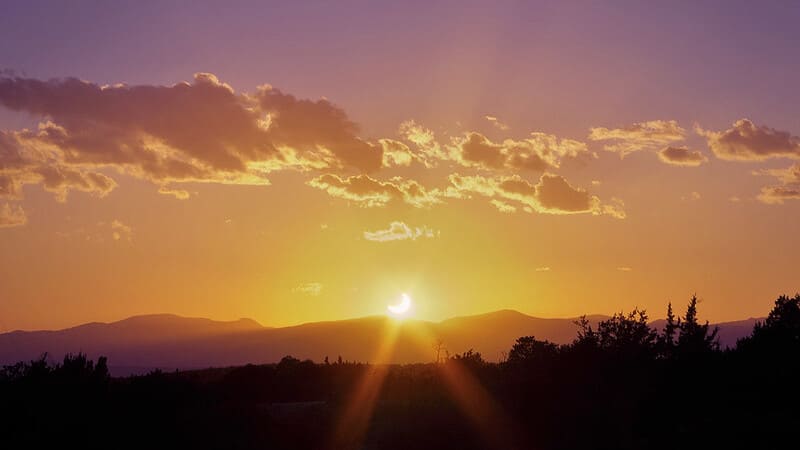
Many myths and misconceptions about viewing a solar eclipse are not based on scientific facts. Some of these myths may discourage people from observing a solar eclipse, while others may encourage them to do so unsafely. Here are some of the most common myths and misconceptions about viewing a solar eclipse and the truth behind them:
Debunking Common Myths
Myth: A solar eclipse can cause harm to pregnant women or unborn babies.
- Truth: There is no scientific evidence that a solar eclipse can affect pregnancy or fetal development in any way. This is a superstition that has no basis in reality. Pregnant women can safely view a solar eclipse with proper eye protection, just like anyone else.
Myth: A solar eclipse can cause blindness, cancer, or other diseases.
- Truth: There is no scientific evidence that a solar eclipse can cause any physical or mental illness, except for eye damage if you look at it without protection. This is a fear that is unfounded and irrational. A solar eclipse is a natural phenomenon that does not emit any harmful radiation or substances.
Myth: A solar eclipse can bring bad luck, misfortune, or disaster.
- Truth: There is no scientific evidence that a solar eclipse can influence human events or destiny in any way. This belief is based on astrology, religion, or folklore. A solar eclipse is a celestial event that does not affect the Earth or its inhabitants except for creating a temporary shadow.
Myth: You can use any dark or tinted material, such as sunglasses, film negatives, CDs, or smoked glass, to view a solar eclipse.
- Truth: These materials are unsafe to use as they do not block enough UV light to prevent eye damage. They may also have defects or scratches that allow more light to pass through. The only safe materials to use are certified eclipse glasses or handheld solar viewers that meet the ISO 12312-2 standard.
Myth: You can look at a solar eclipse without protection if it is cloudy, foggy, or hazy.
- Truth: These weather conditions do not reduce the intensity of the sun’s UV radiation enough to make it safe to look at without protection. They may also clear up suddenly and expose your eyes to the full brightness of the sun. You should always use proper eye protection to view a solar eclipse, regardless of the weather.
Further Reading: Can You See Stars During a Solar Eclipse?
Fostering Correct Understanding
To foster correct understanding and appreciation of viewing a solar eclipse, you should:
- Educate yourself and others about the science and beauty of a solar eclipse using reliable sources of information, such as NASA or The American Astronomical Society.
- Plan and prepare to view a solar eclipse safely, using proper eye protection and following safety guidelines.
- Share your experience and enthusiasm with others, especially children and young people, who may be inspired by witnessing a solar eclipse.
- Avoid spreading or believing myths and misconceptions about viewing a solar eclipse, and correct them if you encounter them.
Summary: Solar Eclipse without Sunglasses
Thank you for reading my article “Can you look at a Solar Eclipse without Sunglasses?”
A solar eclipse, a rare and stunning event, offers a unique opportunity to witness the beauty of nature and gain insights into the sun, moon, and Earth. However, it comes with risks if not approached safely.
A solar eclipse showcases nature’s grandeur, reminding us of our place in the solar system. Despite vast differences in size and distance, the sun and moon align almost perfectly in the sky. This alignment allows the moon to eclipse the sun during a total solar eclipse—a breathtaking spectacle cherished for ages.
Yet, viewing a solar eclipse without proper protection can harm your eyes due to the sun’s UV radiation. To observe safely, always use certified solar viewing glasses, eclipse glasses, a special solar filter, or handheld solar viewers. Avoid using unfiltered optical devices, like camera lenses or telescopes, to prevent severe eye injury.
By respecting nature’s power and prioritizing safety, you can savor the wonder of a solar eclipse while avoiding risks. Share this incredible experience with others, fostering a greater appreciation for this natural phenomenon.
Are you interested in more Solar Eclipse articles?




